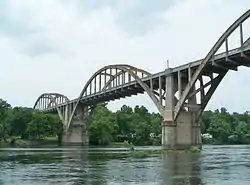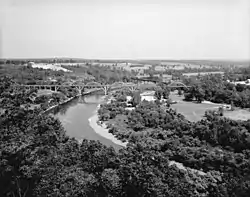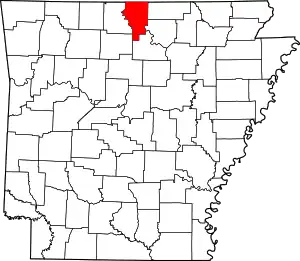Cotter, Arkansas | |
|---|---|
 Cotter Bridge over the White River | |
| Motto: "Trout capital U.S.A." | |
 Location of Cotter in Baxter County, Arkansas. | |
| Coordinates: 36°16′55″N 92°31′16″W / 36.28194°N 92.52111°W[1] | |
| Country | United States |
| State | Arkansas |
| County | Baxter |
| Incorporated | November 23, 1905 |
| Government | |
| • Type | Mayor–council |
| • Mayor | Mac Caradine |
| Area | |
| • Total | 2.45 sq mi (6.34 km2) |
| • Land | 2.45 sq mi (6.34 km2) |
| • Water | 0.00 sq mi (0.00 km2) |
| Elevation | 640 ft (200 m) |
| Population (2020) | |
| • Total | 886 |
| • Density | 362.08/sq mi (139.78/km2) |
| Time zone | UTC-6 (Central (CST)) |
| • Summer (DST) | UTC-5 (CDT) |
| ZIP code | 72626 |
| Area code | 870 |
| FIPS code | 05-15490 |
| GNIS feature ID | 2404136[1] |
| Website | www |
Cotter is a city in Baxter County, Arkansas, United States. The population was 886 at the 2020 census.
History

Native American Bluff Dwellers were the original inhabitants of the area now known as Cotter. When Native Americans were moved westward on the Trail of Tears, approximately 1000 Cherokees crossed just a short distance upriver from the current location of Downtown Cotter.[3]
Exploration and settlement
In 1819, Henry Schoolcraft was exploring the Ozarks and spent a night in the Cotter area. He said of the area,[4]
White River is one of the most beautiful and enchanting streams, and by far the most transparent, which discharge their waters into the Mississippi ... We here behold the assembled tributaries flowing in a smooth, broad. deep, and majestic current ... skirted at a short distance by mountains of the most imposing grandeur.... [The] extreme limpidity and want of colour ... was early seized upon by the French traders on first visiting this stream, in calling it "La Rivière Blanche" (White River).
Future president, Herbert Hoover, spent the summer of 1892 helping Geologist John C. Branner survey the northern Ozarks. By the early 1900s, there were many mining companies active in both Baxter and Marion Counties. Cotter quickly became a central point where minerals could be shipped via steamboat to much larger cities in central Arkansas or southern Missouri.
Originally, the river bend was known as either Lake's Ferry or Lake's Landing. At this spot, the White River turns sharply, making a convenient border for a town. The spring that rises up from the caves beneath Cotter, also added to the appeal to early settlers. Lake's Ferry was known as one of the most beautiful spots on the river and was appreciated by locals and tourists.[5]
White River Line
Seeking to capitalize on the growing trade in the area, the Missouri-Pacific Railroad announced plans to open the White River Line which would run through the area and would connect with the main line in Lake's Landing. By 1902, the Cotter post office had opened. Two years later, the first school in Cotter opened. In 1905, the Missouri Pacific Railroad bought the area and sold over one thousand lots, mostly to railroad employees.[6] The city was incorporated in 1905 as Cotter, Arkansas.[7] By that time, the population was over 600. The town was named after William Cotter, an official for the Missouri Pacific Railway System. The materials required to build the town and railroad had to be brought in by steamboats down the White River. Once the railroad was completed, the use of steamboats on the rivers of Arkansas decreased and eventually ceased altogether. In 1906, the first passenger train arrived, and the tourist era began.
Expulsion of African Americans
The construction of the railroad brought many laborers, including African Americans, to the area. However, once the work was completed the sentiment among white residents turned against them. The anti-Black attitude was encouraged by a visit from Arkansas Governor Jeff Davis, who gave a racist speech in Cotter in 1904, and by the local newspaper, the Cotter Courier. In April 1906 the Courier ran an editorial titled "Too Many Negroes", which said that local residents had a "feeling...that the negroes should move on." In and around August 1906, all of Cotter's African Americans were run out of town, except for one family of three, the Masons. In the 1950s advertisements for Cotter boasted that it was "100 per cent white", and the 1960 census recorded no African American residents.[8]
Cotter Bridge
The mercurial White River caused many motorists problems, as the nearest crossing was over 100 miles (160 km) to the north in Branson, Missouri. An inconvenient ferry system made the need for a bridge apparent. Locals wanted a bridge, but they strongly opposed a toll bridge.[9] Arkansas did not have a central highway body at the time, and was instead a patchwork of "road districts", which made the bridge-building efforts even more difficult. Without a toll, funding wasn't available until Arkansas Highway 12 was redesignated U.S. Route 62 in 1930. The Cotter Bridge was constructed through the area using a unique rainbow arch design.
Geography
According to the United States Census Bureau, the city has a total area of 2.5 square miles (6.5 km2), all land.
Demographics
| Census | Pop. | Note | %± |
|---|---|---|---|
| 1910 | 894 | — | |
| 1920 | 884 | −1.1% | |
| 1930 | 1,064 | 20.4% | |
| 1940 | 903 | −15.1% | |
| 1950 | 1,089 | 20.6% | |
| 1960 | 683 | −37.3% | |
| 1970 | 858 | 25.6% | |
| 1980 | 920 | 7.2% | |
| 1990 | 867 | −5.8% | |
| 2000 | 921 | 6.2% | |
| 2010 | 970 | 5.3% | |
| 2020 | 886 | −8.7% | |
| U.S. Decennial Census[10] | |||
2020 census
| Race | Number | Percentage |
|---|---|---|
| White (non-Hispanic) | 784 | 88.49% |
| Black or African American (non-Hispanic) | 1 | 0.11% |
| Native American | 7 | 0.79% |
| Asian | 4 | 0.45% |
| Other/Mixed | 68 | 7.67% |
| Hispanic or Latino | 22 | 2.48% |
As of the 2020 United States census, there were 886 people, 419 households, and 271 families residing in the city.
2010 census
As of the census[12] of 2010, there were 1,078 people, 472 households and 293 families residing in the city. The population density was 373.6 inhabitants per square mile (144.2/km2). There were 501 housing units at an average density of 203.2 per square mile (78.5/km2). The racial makeup of the city was 97.07% White, 0.87% Native American, 0.22% Asian, and 1.85% from two or more races. 1.52% of the population were Hispanic or Latino of any race.
There were 545[13] households, out of which 20.8% had children under the age of 18 living with them, 48.5% were married couples living together, 8.6% had a female householder with no husband present, and 40.0% were non-families. 35.4% of all households were made up of individuals, and 16.7% had someone living alone who was 65 years of age or older. The average household size was 2.08 and the average family size was 2.67.
In the city, the population was spread out, with 19.7% under the age of 18, 8.7% from 18 to 24, 24.8% from 25 to 44, 26.7% from 45 to 64, and 20.2% who were 65 years of age or older. The median age was 43 years. For every 100 females, there were 97.2 males. For every 100 females age 18 and over, there were 99.5 males.
The median income for a household in the city was $22,857, and the median income for a family was $34,375. Males had a median income of $26,298 versus $17,266 for females. The per capita income for the city was $15,893. About 11.9% of families and 16.8% of the population were below the poverty line, including 18.3% of those under age 18 and 13.3% of those age 65 or over.
Education
Formal education in Cotter began with Miss Cora Patterson teaching 40 students under a tent on January 4, 1904.[14] In 1915, Cotter schools merged with the East Cotter School District, with the Gassville and Whiteville districts merging into Cotter in 1948.
Today, public education is provided by the Cotter School District including Cotter High School (grades 7 through 12) and Amanda Gist Elementary School (kindergarten through grade 6).[15]
Media
Cotter and Baxter County are within the Springfield, Missouri TV market.
The city has been home to five newspapers over the years, the longest lasting being the Cotter Courier (1903-c. 1918)[16] and The Cotter Record (1911-1937).[17] Publications lasting only a year or so include The White River Headlight,[16] The Screech Owl, and the Bull Shoals Gazette.[17] Today, Cotter news is covered by The Baxter Bulletin.
Infrastructure
List of highways
Railroads
Cotter has one local railroad, the Missouri and Northern Arkansas Railroad. The MNA leases the track from Newport to Kansas City, Missouri, from the Union Pacific. The regular train traffic are empty coal trains from The Independence power plant, as well as a north and south local out of Cotter. Additionally, there is a small railyard and crew change point
Airports
Cotter is accessible to two separate commercial airports, Ozark Regional Airport (Baxter County) and Flippin Municipal Airport (Marion County). There is also a rural air field, Valley Airport, located on Denton Ferry Road that serves small planes owned by residents.
References
- 1 2 3 U.S. Geological Survey Geographic Names Information System: Cotter, Arkansas
- ↑ "2020 U.S. Gazetteer Files". United States Census Bureau. Retrieved October 29, 2021.
- ↑ "Cotter, Arkansas, history: Anne Ramey". Archived from the original on January 15, 2011. Retrieved August 20, 2010.
- ↑ Scenes and Adventures in the Semi-Alpine Regions of the Ozark of Missouri and Arkansas (1853) pg 120-121
- ↑ "Early History of Cotter, Arkansas, site of the Railroad Workers Memorial". Archived from the original on August 21, 2013. Retrieved April 10, 2013.
- ↑ Bennett, Lola and Smith, Corinne. "Historic American Engineering Record Cotter Bridge (R.M. Ruthven Bridge)." 1988.History. Archived December 13, 2010, at the Wayback Machine Page 3. Retrieved August 20, 2010.
- ↑ Ramey, Ann. "Cotter Historical Briefs." History. Archived 2011-01-15 at the Wayback Machine Retrieved August 20, 2010.
- ↑ Lancaster, Guy. "Cotter Expulsion of 1906". CALS Encyclopedia of Arkansas. Central Arkansas Library System. Retrieved September 28, 2020.
- ↑ Bennett, Lola and Smith, Corinne. "Historic American Engineering Record Cotter Bridge (R.M. Ruthven Bridge)." 1988. History. Archived December 13, 2010, at the Wayback Machine Page 6. Retrieved August 20, 2010.
- ↑ "Census of Population and Housing". Census.gov. Retrieved June 4, 2015.
- ↑ "Explore Census Data". data.census.gov. Retrieved January 1, 2022.
- ↑ "U.S. Census website". United States Census Bureau. Retrieved January 31, 2008.
- ↑ "2010 Census Results". Retrieved April 9, 2011.
- ↑ McClelland, Frances Shiras (December 1982). History of Baxter County, Arkansas: from the beginning to 1939 (2nd printing ed.). Saint Louis University. p. 52. OCLC 733695700.
- ↑ School District Reference Map (2010 Census) Baxter County, AR (PDF) (Map). US Census Bureau. Retrieved July 12, 2011.
- 1 2 Allsopp, Frederick W. (1922). History of the Arkansas Press for a Hundred Years and More (PDF) (Reprint ed.). Little Rock, Ark: Parke-Harper Pub. Co. p. 60. ISBN 9780893080730. OCLC 3576168 – via Southern Historical Press.
- 1 2 Meriwether, Robert W. (1974). A Chronicle of Arkansas Newspapers Published Since 1922 and of the Arkansas Press Association, 1930-1972. Little Rock, Ark: Arkansas Press Association. p. 5. OCLC 2146483.
External links
- Map of Cotter (US Census Bureau)
- Map of Baxter County (US Census Bureau)
- Baxter County Historical and Genealogical Society
